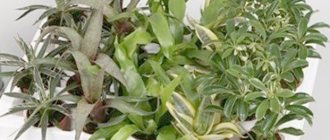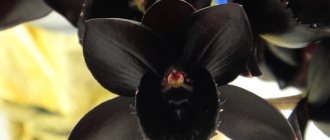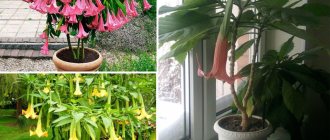In the gardens of flower growers, there are more and more representatives of plants that belong to the bulbous family. Caring for them is not so easy. However, crinum, although it belongs to the bulbous species, still has a pleasant character. It withstands temperature changes.
Author of the article
Maxim Sverchkov
Professional biologist and breeder with extensive experience and experience.
It is not so difficult to find the right conditions for him. Many gardeners still do not know about this giant. However, if at least once they see large flowers of a delicate shade, leaves of extraordinary length, then the crinum flower will remain in their memory for a long time.
You may be interested in the article: Echeveria: watering, care and propagation.
Characteristic
The time has passed when flower growers only had hippeastrums on their windowsills. Now krinums are gaining popularity. After all, they have flowers of such attractive sizes and such different shades. It is difficult to find a plant that would differ in the same shapes.
However, to see such beauty in your room, you need to provide careful care. Only if all conditions are met is it possible that those long-awaited buds will appear.
Bulbous plants are difficult to care for. Many people know this. That's why they are afraid to start a krinum. However, if you read a little about its growing conditions, you can understand that, despite the fact that it is also a bulbous plant, it is not considered demanding.
This plant is considered quite large in relation to other representatives of bulbous plants. The second name for krinum is krin. Translated from Latin it means “hair”. A more poetic name for the plant is pink lily. It belongs to the Amaryllis family.
While some believe that this plant is an ornamental flowering plant. Others argue that it belongs to the decorative deciduous family. In fact, kreen have characteristics of both types.
We recommend that you read the article: Tolmia Menzisa: care at home.
General characteristics:
- His neck is quite elongated. Its length varies from sixty to ninety centimeters.
- In terms of size, the crinum bulb is classified as large. After all, its diameter reaches twenty-five centimeters.
- The roots are very powerful and superficial. If you see that the root system is even crawling out of the soil, then you should not draw premature conclusions. This is not a lack of land. This is simply a feature of this plant.
- Krinum has a pseudostem.
- Many leaves. In their shape they are lanceolate-linear. They are quite long (usually more than one meter), so they fall beautifully.
- If the leaves are still young, they are rolled into tubes.
The flowering period begins in early spring and ends only in autumn. At this time, you can see how buds appear on the peduncles, and then flowers bloom, the diameter of which reaches fifteen centimeters.
The flowers can easily be confused with a lily. They are the same shape. However, the shades are slightly different. Krinum alternates between white and pink. The smell is not strong, but quite pleasant.
Seeds can only appear if the flower is artificially pollinated. At the same time, it is interesting to note that if the seeds do appear, then you will notice that in addition to them, there will also be water in the box. It will be enough for the seeds to germinate.
How to plant and replant indoor crinum in a pot
The flowerpot and soil for adult specimens should be changed once every 3-4 years. This should only be done when the plant is resting. Planting is carried out in such a way that the bulb is half above the soil level.
Only a deep container is used for krinum. This is due to a well-developed root system. A layer of drainage should be laid at the bottom of the flowerpot, which can be used as crushed red brick, pebbles or expanded clay.
This video shows how Asian crinum blooms and how to replant the plant correctly.
Varieties
Many species can be seen in the natural environment. There are several hundred in total. However, only seventeen are grown at home. Only three are considered the most common.
Crinum Moore
The most popular type. It was he who was nicknamed the pink lily. Its homeland is South Africa. Also refers to bulbous. Comparing the bulb of this species with others, you can notice how large it is.
Its dimensions vary from twenty to twenty-two centimeters. The neck of this bulb can easily be confused with the stem, as it protrudes from the ground by as much as forty to sixty centimeters. According to their shape, the leaves are classified as wavy. Many admire their beauty.
They reach sixty to ninety centimeters in length. If you care for the plant properly, the leaves will appear glossy. And their color will be bright and saturated. From six to nine flowers can appear on each peduncle. A photo of a crinum flower will show how similar the plant is to a lily. The size of the flowers varies from ten to twelve centimeters.
The following plants are much less common. However, they also appear among flower growers who are passionate about their work.
Krinum asiatica
This bulbous plant has a bulb that is slightly smaller in diameter. The maximum size is fifteen centimeters. The neck is located at a height of thirty-five centimeters above the ground. The leaves are huge. Usually their length exceeds even a meter. They reach ten centimeters in width.
The edge, unlike the crinum mura, is not wavy, but smooth. The number of flowers varies from twenty to fifty. Each has a long peduncle. They are all whitish in color. They are especially noticeable due to the bright red stamens. The flowering period begins in March and ends in mid-October.
Krinum Yagus
The most compact of all the listed crinums. Its bulb reaches ten centimeters in diameter. The pseudostem rises only a few centimeters above the ground. The leaves are long.
Their usual sizes vary from sixty to ninety centimeters. The edge of the foliage is wavy. Each peduncle contains from three to twelve flowers. The flowers are huge. Each one is approximately twenty centimeters long. The wide white petals are attractive. The flowering period of this species begins in June and ends in August.
Frequent pest and disease problems
Adonis flower - planting and care in open ground
The most common problems with crinum are insects that feed on the foliage, as well as infections that disrupt vital processes. The most common diseases are:
- gray rot;
- anthractosis;
- staganospora.
Diseases appear due to high humidity and decreased immunity. If uncharacteristic spots of gray, black, brown or white appear on the leaves, flowers and bulbs, then treatment must be carried out. For this purpose, use a 2% solution of foundationazole or another fungicide for flowering crops.
White crinum
The following insects like to eat crinum leaves:
- mealybug;
- spider mite;
- scale insect;
- aphids;
- thrips.
Pest infestation is easy to notice. Holes appear in parts of the plant, insects are visible, there are cobwebs and plaques that can be wiped off with your finger. In this case, the flower is sprayed with an insecticide for flowering crops.
Crinum is a tropical plant that surprises with its beauty. It can often be found in landscape design and home interiors. The flower is not very demanding to care for. Gives you the opportunity to grow yourself in any climate zone. However, for the winter it is better to transplant crinum into a pot. Some of its species decorate the aquariums of fish lovers. Taking care of them will not be a hassle.
Caring for a plant at home
Indoor crinum is not so difficult to care for due to the fact that the plant is drought-resistant. This bulbous plant can easily cope with the fact that a person forgot to water it. This plant is especially suitable for beginners, still inexperienced gardeners.
If the humidity in the room in which the plant is located changes, this will also not harm the plant. It doesn’t matter what the conditions are: too wet or too dry. Krinum copes with all this.
It should be noted that the plant will delight only in the warm season. In winter, early spring and late autumn it will look neglected. Even if you take good care of it.
Why is this happening? It's all about the resting phase. It comes precisely at this time. During such periods, the plant does not need care. And it’s as if he’s trying to demonstrate this with all his appearance.
Lighting
This bulbous plant loves not just light, but the light that comes from the sun. Its growth and proper development primarily depend on how intense the lighting is. As intensity increases, growth increases. The best place for krinum is the window sill of your apartment.
To prevent the plant from losing its leaves, it does not need to be removed from the light even during dormancy. After all, even in winter it grows, new, young leaves appear.
If the leaves begin to fall, it means the problem is the lighting. Its intensity must be increased to the maximum.
It doesn't matter what source the light comes from. Even a simple lamp will have a good effect on development. However, if the krinum is located far from the windows, additional lighting should be at least sixteen to eighteen hours. Only then will development be complete.
Temperature
Crinums love both light and warmth. Therefore, if possible, it is necessary to monitor the temperature. And do not allow the degree to drop below fourteen. The most cold-resistant plant among domestic species is Crinum Moore. For him, the minimum temperature is six degrees.
During dormancy, the plant should be placed in a cool place. Here the temperature should not be higher than eighteen degrees. It's okay if you can't lower the temperature. After all, crinum is a patient plant.
It does not react even to sudden changes in temperature. They can be moved to a new location at any time. Nothing bad will happen. The main thing is to gradually accustom the plant to a new place. You should not immediately place it in bright sun from a cold, shaded place.
If crinum grows in an apartment, then regular ventilation will be useful for it.
Watering
Typically, bulbous plants do not really like heavy watering. Crinum, although it belongs to this genus, likes the soil to always be moist. With the onset of cold weather, the amount of watering should be gradually reduced. This way the plant itself will enter the sleep phase.
Watering is the most difficult part of caring for this plant.
After all, it depends on it how well the creen will survive the winter period. It is not recommended to completely remove watering. You need to keep it to a minimum and carefully monitor the soil. It should not be completely dry. After all, the root system lives throughout the year. She needs food.
As soon as it becomes clear that the plant begins to bloom, the intensity of watering is also gradually increased.
Watering is something that especially affects the development of a plant. That is why if there is a failure in watering, there will be a failure in the growth stages. It is necessary to water with water at room temperature. Humidity does not affect the development of the plant.
Therefore, it does not need to be reduced or increased by artificial means. The only thing you need to do besides watering is to remove dust from the foliage.
Feeding
It is necessary to fertilize every two weeks during active development and growth. Regular mixtures will not work. We need those designed for flowering plants.
Trimming
You can trim dried leaves only if they are completely dry. If not, then you need to wait.
Transfer
It is advisable to replant Krinum every two to three years.
Any soil is suitable for replanting. The main thing is that it is loose. It is better if the air flows through it calmly.
If you decide to prepare the soil yourself, you must:
- take a share of sand;
- mix it with the same portion of deciduous soil;
- add humus;
- mix in two more portions of turf soil.
Garden crinum in winter
Krinum bulbs ready for wintering photo
Overwintering of crinum is possible only with the vigilant care of the grower. In the fall, it is necessary to cover the bulbs with a thick layer of peat or replace the mulch with straw up to half a meter thick (then it will settle). In the spring, as soon as the frosts pass and the snow melts, the mulch is removed so that the bulbs wake up quickly and do not rot.
If you have frosty winters, it is better to dig up the bulbs, dry them slightly in the shade and store them in the refrigerator in the vegetable section. Garden crinums can also simply be transplanted into pots and placed in a dark, cool place; they contain plants without watering.
Plants grown in containers are brought into cold rooms, where in winter the temperature will be about 5 ° C. If there is a threat of a drop to zero, it is necessary to cover with warm covering materials.
By the way, some gardeners prefer not to take risks, because after the crinum has flowered, the rainy season may well begin, which can provoke rotting of the bulbs. Therefore, crinums are dug up, trimmed, dried in the shade and sent for storage in a cool, dry room (the bulbs can be sprinkled with dry sawdust and stored in boxes at +5 ° C).
Preparing crinum bulbs for storage photo
Reproduction
The easiest and fastest way to propagate crinum is by daughter bulbs.
The optimal time for crinum propagation is summer. The “babies” are carefully separated from the mother plant so as not to damage the roots. The cut areas are treated with crushed coal.
Each bulb is planted in an individual pot with a diameter of 9-12 cm. The young specimen should be kept in a well-lit place and watered moderately.
After a year, the plants are transferred to pots with a diameter of 12-15 cm, and after another 12 months - with a diameter of 15-17 cm. During the growth period, good watering and fertilizing are necessary.
Depending on the size of the crinum bulbs, children bloom 2-4 years after planting.
Light for life
And then follow the instructions for caring for the crinum. Its nature requires more natural light and electric lighting on gloomy days. After winter, gradually accustom it to the sun's rays; it is better to keep the pot on a south window. Remember: the more light, the faster you will get luxurious flowers.
During the summer, keep it outside with slight leafy shade from trees, and not in heavy rain. The room will have to be ventilated often. This procedure is also required at other times of the year. Daylight hours for crinum are 16 hours.
The soil
The soil for crinum should be loose and fertile. You can buy a ready-made universal substrate in the store or prepare the mixture yourself.
Having chosen the second option, you should prepare turf and leaf soil, humus, peat and sand in a ratio of 2:1:1:1:1. You can add a few pieces of charcoal.
Before planting, the mixture should be disinfected by spilling it with a weak solution of potassium permanganate. A pot with large holes and good drainage at the bottom is an important part of growing the plant successfully.
Watering
During the period of growth and flowering, crinum requires abundant watering. However, it is not recommended to over-moisten the soil.
Before the next watering, the top layer of soil must dry out . After the plant has flowered, the volume and frequency of soil moisture decreases.
In winter, when kept in cool conditions, watering should be quite rare - once every 2-3 weeks.
However, the soil should not be allowed to dry out - the fleshy roots do not stop functioning all year round. With the appearance of the flower arrow, the normal watering regime is restored.
The water used for irrigation should be soft and at room temperature.











